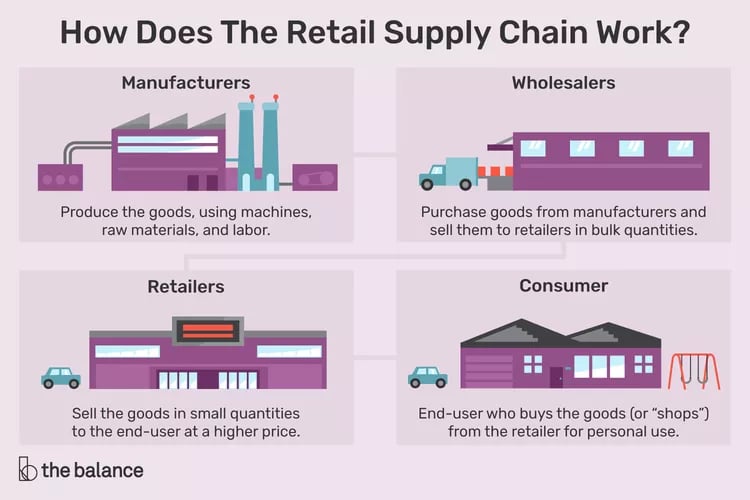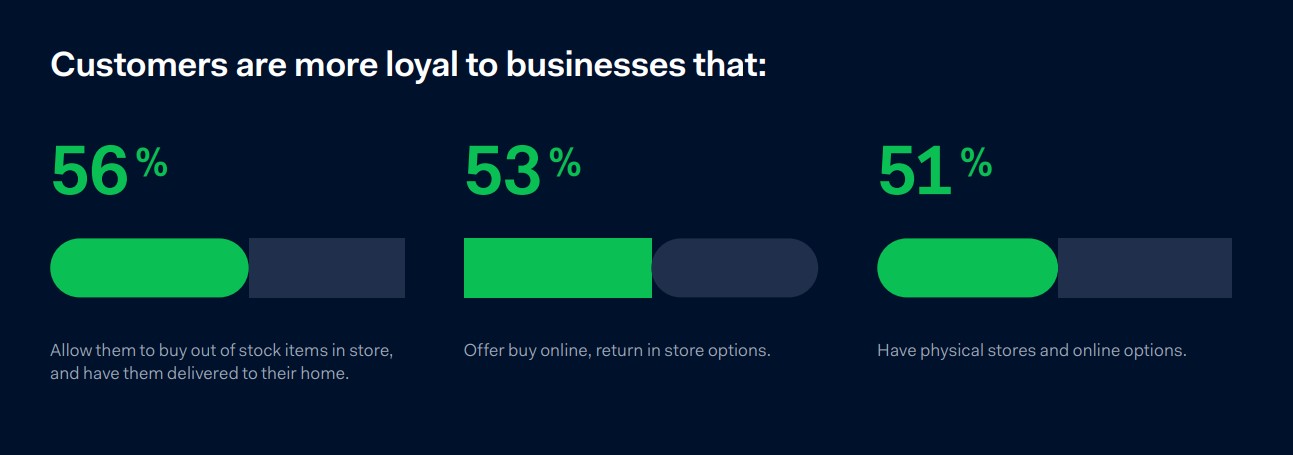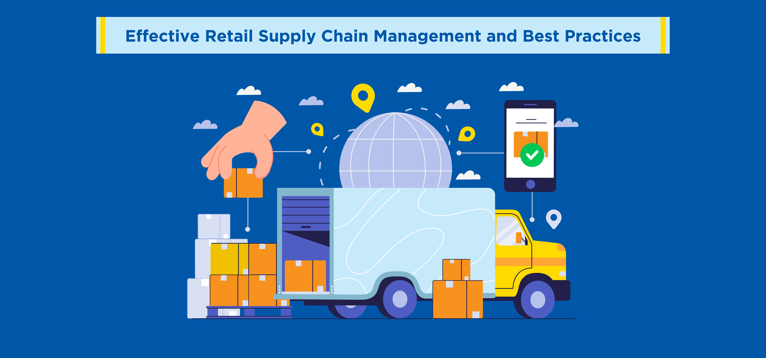Today's retailers are witnessing high-volume, high-velocity, high-mix distribution and fulfilment environments. Once viewed as a cost centre, retail supply chains are now considered as important for successful business as sales and marketing.
This radical shift in the retail landscape is accelerating the need to rethink the traditional retail supply chain model. No wonder, nearly all retailers plan to make their retail supply chain more agile (96%) and more resilient (90%).
So the question is not whether change is required. But it is—how retailers can hone retail supply chain management and make it a competitive advantage without lowering margins.
In this article, we’ll walk you through an overview of the retail supply chain and the importance of supply chain management in retailing. Followed by this will be supply chain management best practices recommended by our retail supply chain experts.
What Is the Retail Supply Chain?
Retail is a broad term for the sale of goods and services from a business to consumers—not for further sale, but for their consumption. It encompasses physical stores, eCommerce stores as well as mobile stores.
A retail supply chain is the flow of processes that moves a product from the point of origin to the point of consumption.
In other words, the entire journey of products, from its manufacturing or acquisition to its distribution and delivery into the hands of end customers, makes up the retail supply chain process flow.

Different elements of a typical retail supply chain are as follows:
- Product manufacturing/acquisition
- Procurement and inventory management
- Warehousing and order management
- Picking and packing
- Shipping and fulfilment
- Carrier partnerships
- Product return management
What Is Retail Supply Chain Management?
Retailers and suppliers are sprinting to get more goods to more destinations faster.
Talk about Australia—the eleventh-largest eCommerce market in the world. It is predicted to reach USD 32.3 billion by 2024, with a year-on-year increase of 15.5 per cent.
But wait till you see the following numbers.
While in the last couple of years, eCommerce became a lifeline for retail businesses enabling them to offset losses from brick-and-mortar retail stores, 73% of Australians prefer to shop in physical stores. Still, 67% of consumers treat physical stores as a crucial touchpoint, even if they shop online with the same retailer.
This outlook of shoppers—getting the best of both worlds, is the key driver in the retail supply chain trend of offering both online and offline channels.

Along with this, many other disruptive trends have shaken the retail supply chain and turned conventional supply chain management principles on their head.
So what should retailers do to ensure supply chain continuity while laying the foundation for future resilience?
The answer is retail supply chain management.
Supply chain management in the retail industry is the process of managing the supply chain of retail businesses. It involves optimising the inbound and outbound logistics to:
- Establish a robust distribution network
- Cut costs
- Deliver faster
- Keep customer satisfaction high
Why Is It Important?
One of the most obvious reasons to closely monitor the retail supply chain is the retail’s fast-moving nature and high volume of products. If the supply chain is slow or improperly maintained, you can not grow your retail business efficiently.
Other reasons to prioritise your retail supply chain management are as follows:
- It enables accurate demand forecasting, so you don’t run the risk of overstocks and stockouts.
- It minimises the lag time between different components of the retail supply chain.
- It optimises your order fulfilment and reduces fulfilment costs.
- The right supply improves customer experience and fosters customer trust.
Top 7 Supply Chain Management Best Practices for Retailers
Retailers can embed efficiency and resilience in their existing supply chain with the y following supply chain management best practices.
1. Track and Manage Inventory in Real-Time
Uncertain customer behaviour and complex retail supply chains make it harder for retailers to align supply with demand. The result is:
- Too much inventory that binds working capital and increases storage costs.
or
- Insufficient inventory that leads to lost revenue opportunities.
A solution to this is to implement cloud-based inventory management software. It tracks demand changes and inventory levels in real-time. By monitoring product velocity it automatically records the existing stock per item. This way, retailers can make data-enabled decisions while preparing for seasonal trends and demand fluctuations.
2. Build Long-Term Alliances with Suppliers
Retailers should explore strong partnerships with suppliers as a way to boost reliability and mutual benefits.
For instance, investing in long-term contracts enables them to combat price volatility. That's because suppliers usually tend to prioritise strategic and multiyear agreements over short-term and transactional ones. It is especially true for freight carriers and warehousing partners. Long-term contracts can help retailers convince their warehouse partners to limit the annual rent increase and to secure predictable costs and storage capacity.
3. Improve Demand Forecasting
Accurate demand forecasting develops the best possible understanding of the future product demand. It is integral to the health of your retail supply chain.
Retailers can leverage demand forecasting data to improve decision-making in areas like stock replenishment in store and distribution centres, capacity planning, resource allocation, etc.
With the accurate calculation of items that will sell at any given time, businesses can order those products accordingly.
Another key benefit lies in optimised production capacity. It results from accurately forecasting the amount of raw material needed to produce the goods.
Moreover, better visualisation of the capacity requirements eliminates bottlenecks and increases fulfilment reliability.
4. Apply End-To-End Supply Chain Visibility
Supply chain visibility is about capturing data related to material, capital, and organisational information throughout the retail supply chain at any given time. Retailers then turn that data into intelligence for decision-making.
Retail businesses can strengthen their supply chain management plan by:
- Gaining end-to-end views of their supply and distribution flow.
- Having a birds-eye view of the entire supply chain, including partners, suppliers, carriers, fulfilment centres, warehouses, etc.
- Tracking raw materials from suppliers to manufacturers.
- Overseeing movement of finished goods from manufacturers to logistics partners to customers.
- Keeping tabs on each unit of each product throughout the product life cycle.
- Gathering real-time data on inventory levels, shipping information, order status, etc.
5. Invest in Technology
In the fast-moving retail business landscape, separate systems for different supply chain parts do more harm than good. When distinct retail supply chain software does not exchange information, the outcome is an information silo. Manual processes are another costly mistake that many retail businesses commit. All this leads to inaccurate forecasts and lengthy reaction times.
Therefore, retailers must explore advanced analytics technologies, document digitisation, and automation. A retail supply chain management solution is perhaps the most powerful tool in streamlining all the aspects of a retail supply chain.
These tools help you overcome silos and improve overall supply chain performance. Moreover, they empower their internal teams and supply chain partners with visibility and collaboration.
6. Partner with 3PL
By now, you must have decoded the complexities of successful retail supply chain management. Naturally, a lot goes into an optimised supply chain in terms of technology, logistics and industry know-how.
That’s why many retail businesses outsource their supply chain operations to a third-party logistics provider. A 3PL offers services in warehouse management, order fulfilment and distribution, inventory management, reverse logistics, and more.
An established 3PL like PACK & SEND confers added value to your supply chain by powering it with tailored solutions, advanced technology, and best-in-class customer support.
That way, you can worry less about supply chain management and focus more on growing your business.
Wrapping Up
Retailers interested in setting up their businesses for long-term growth must readjust their retail supply chain for resilience and agility. And the best practices outlined above are a great starting point for laying the foundation of a successful retail supply chain management.
To learn more about how PACK & SEND works for your business, contact us now!
Image source: The Balance, Adyen
